Robinvale
Robinvale on Google maps. View Larger Map
Robinvale is situated on the River Murray in north western Victoria. The town was built in the 1920s as a business centre for a wheat farming district. When full scale irrigation was established in the late 1940s horticulture became the region’s major industry. Robinvale’s population of around 7,000 includes residents from more than 40 different countries of origin.
The world in Robinvale
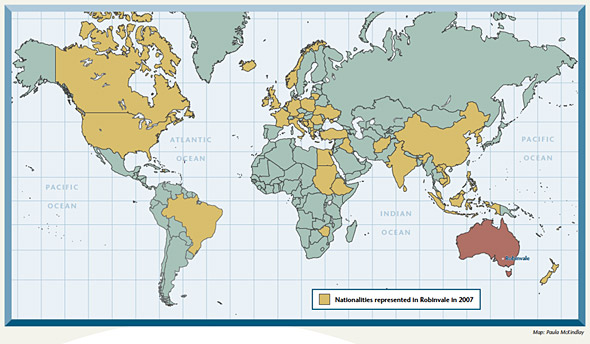
Map of nationalities in Robinvale in 2007. Introduction, panel two, Migration Memories: Robinvale, Designer: Paula McKindlay
Local migration history in the Migration Memories exhibitions
Pastoral colonisation, the displacement of Indigenous people, the construction of the town of Robinvale and the development of full scale irrigation were seen as main elements of Robinvale’s particular migration history. Research also identified distinct forms of migration shaped by Australian immigration history more generally and the development of Robinvale since irrigation. In the exhibitions a timeline juxtaposed key migration events in Australia with local developments.
A personal migration story was developed for each significant migration context.
Colonial pastoral migrations
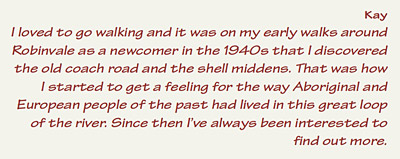 |
||
| Detail, Kay Grose, panel one, Migration Memories: Robinvale. Design: Paula McKindlay |
British pastoralists were acquiring land along the River Murray in western Victoria by the 1840s. The family who settled in the immediate vicinity of Robinvale had migrated from Scotland on a scheme for people who had lost their livelihood through the Highland Clearances. Indigenous people in the region kept their connection to country as much as they could through new forms of work.
Kay Grose’s story focused on the experience of the first British landholder in the Robinvale area and the impact of pastoral activity on Indigenous people.
Go to Kay Grose >
The Indigenous experience
 |
||
| Detail, Aunty Rose Kirby, panel one, Migration Memories: Robinvale. Design: Paula McKindlay. |
Tribes from along the River Murray in western New South Wales and Victoria tried to stay on their lands once the British came, but often had to live on government settlements. They worked in various capacities for the newcomers and, when irrigation began along the Murray, they also became seasonal horticultural workers. Amongst those who came to Robinvale for work in the 1950s, a number were returning to traditional territory.
When Aunty Rose Kirby came to work in Robinvale in the 1950s she camped along the river with other Indigenous people. A few years later they were moved to a settlement on the edge of town called Manatunga. She is now one of the Manatunga Elders, a group from different tribal backgrounds, who work together to support Indigenous people in Robinvale.
Go to Aunty Rose Kirby >
Building a township and irrigation settlement
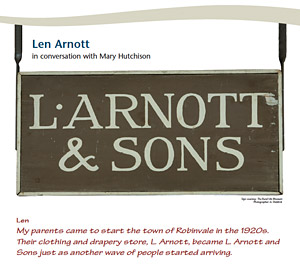 |
||
| Details from Len Arnott, panels one and three, Migration Memories: Robinvale. Design: Paula McKindlay |
Robinvale township was developed in the aftermath of the first World War when there was a great push to settle more people in rural Australia. Those who took up the opportunity to start business in the new town came mainly from other parts of Victoria. The first ‘blockies’, who came to grow grapes on the new irrigation settlement twenty five years later, were also from nearby. The first overseas arrivals after the Second World War were refugees from Europe who, as part Australia’s post-war Immigration Program, were sent to work on the construction for irrigation.
Len Arnott’s story covered two periods of Robinvale’s growth: the beginning of the town in the 1920s and the beginning of the irrigation settlement in the late 1940s. The second period included the experience of Vince Szewcuk and his family who boarded with the Arnotts until they could get their own place.
Go to Len Arnott and Szewcuk family >
The first generation of market gardeners – the beginnings of Robinvale’s horticultural industry
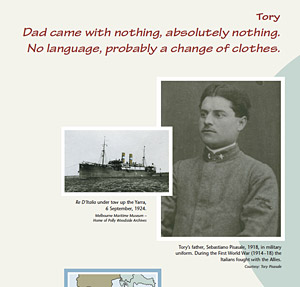 |
||
| Detail, Tory Pisasale, panel one, Migration Memories: Robinvale. Design: Paula McKindlay |
In the years following the establishment of the town, land near the river was leased for market gardening. During the 1930s a number of Italians who had come to Australia in the 1920s took up the leases and established successful horticultural businesses. Their experience was marked by the strong anti-Italian sentiment that developed with the Second World War and government regulation of their activities.
Tory Pisasale’s story was about his parents’ migration from Sicily and their contribution to Robinvale’s early horticultural industry.
Go to Tory Pisasale >
Italian and Greek ‘blockies’ in the post-war period
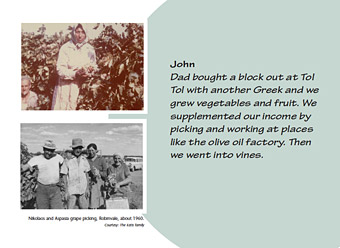 |
||
| Detail, John Katis, panel two, Migration Memories: Robinvale. Design: Paula McKindlay. |
Irrigation and grape growing in Robinvale in the post-war period created seasonal work that was often taken up by recent migrants to Australia. During the 1950s and 60s, when new land became available, families who had often had first hand experience of the locality, came to create market gardens. Once established they bought grape blocks. They were predominantly from Italy and Greece.
John Katis’s family came to Australia from Greece in 1955. Two years later they came to Robinvale with another Greek family to develop a block of land for market gardening.
Go to John Katis >
Horticultural workers from the Pacific Islands
 |
||
| Detail, Maamaloa-Fine family, panel one, Migration Memories: Robinvale. Design: Paula McKindlay. |
Pacific Islanders came to Australia in the 1970s mainly to work in urban industries. With changes in the economy and workforce requirements many sought alternative work. Since the 1980s a strong Tongan community has developed in Robinvale, providing contract labour for the agribusinesses that have been part of the Robinvale landscape since the late 1970s.
Maamaloa came to Robinvale for seasonal work and then settled permanently with his family in the mid 1980s.
Go to Maamaloa-Fine family >
Asian business owners and recent refugees
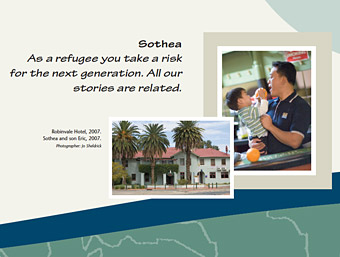 |
||
| Detail, Sothea Thea, panel four, Migration Memories: Robinvale. Design: Paula McKindlay. |
The two most recent migrations to Robinvale are those of South East Asians and refugees from Afghanistan. Asians, often from Melbourne, have been coming to Robinvale in significant numbers for seasonal work since the 1990s. Some have settled permanently. Asian business owners manage contract labour and have bought shops in the main street of town. A small number of Afghani refugees have come to Robinvale since the Australian Government announced its intention to increase the settlement of migrants and refugees in regional areas in 2004. It was not possible for Migration Memories to work with this very new and raw story but Sothea’s story, which was part of the growth of Asian businesses, reflected on the refugee experience.
Sothea Thea came to Robinvale in 2004 to manage the Robinvale Hotel for a group of Cambodian businessmen which included his father-in-law. He arrived in Australia by boat in 1990 as a sixteen-year old escaping Cambodia’s civil war. He was amongst the first refugees to be held in a detention centre.
Go to Sothea Thea>
